When Liverpool Women were relegated to the Women’s Championship last summer, many thought they would make an immediate return to the WSL after just one season in the second division. However, at time of writing, they sit third in the table, five points behind second-placed Durham Women, and eight behind leaders Leicester City Women. Their results have not been bad, having lost just one of their last five games, and only losing two overall to date, but the fact that they are not where they would have hoped to be has been a reason for the departure of manager Vicky Jepson this week.
The club has faced criticism for the way the women’s team has been left in disarray and without proper support from the men’s team and owners, but, rather than getting into the off-the-field issues with the club, this tactical analysis will focus on where the new manager needs to make changes on the pitch, looking to help them close the gap to the top of the table. We will look at their tactics in attack and defence, seeking to suggest ways that they can become tighter at the back and more productive at the front, which will serve them well when they do return to the WSL at some stage in the future.
Final third play
We will begin this scout report by looking at Liverpool Women’s attack, specifically at their play in the final third. They generally set up in a 4-2-3-1 formation, but one of their holding midfielders stays back to protect the defence, allowing the rest to get forward and support the attack. The image below shows how this works.

Wales midfielder Rhiannon Roberts has the ball here, and you can see how she is in a good central position. From here, she can move the ball into teammates around the pitch, acting as a pivot. Liverpool this season have an average passing accuracy of 75%, and a 57.6% accuracy of passes to the final third, so we can see how this tactic helps them to play to their strengths. With Liverpool using attacking full-backs, this positioning also allows Roberts to slot into defence when needed if they are short at the back.
If we use this setup to look at Liverpool in the final third, we should see plenty of players in and around the box, supporting the lone striker. However, as is evident below, this is not usually the case.

One of Liverpool’s summer signings was Denmark striker Amalie Thestrup from Roma Femminile, and, whilst she has led the line well this season, she has mostly operated on her own. The image shows how she is in the box, ready to receive the ball from Rinsola Babajide, in the red circle, on the far side of the pitch. However, the white circles show how the two players nearest to Thestrup are a long way outside the goal area, and therefore aren’t really in a position to receive the ball and shoot at goal. Therefore, Thestrup is the only option available in the box, making it easier for the Durham defenders to mark her and harder for Liverpool to score from this opportunity.
When they do have chances, Liverpool only get 33.2% of their shots on target, and so they need to improve their overall attacking play in order to maximise each opportunity. In order to fix this here, the two supporting players needed to get further forward, offering themselves as viable options for Babajide to find with the cross. They have an average expected goals (xG) value of 1.76 this season, but have only scored an average of 1.57 goals per game, so these numbers suggest that there is plenty of room for them to make improvements to their play in the final third.
The other thing to mention is that Liverpool’s crossing is often what lets them down in these situations. Here, Babajide’s cross is low, and ends up being intercepted easily and cleared by the defenders. Liverpool’s average crossing accuracy this season is a very disappointing 22.9%, so this is a big factor in their final third struggles. Therefore, as well as their positioning in the middle, they also need to improve the quality of the balls coming into the box, as this will also help them to be more productive in the final third.


However, there have also been occasions when Liverpool have looked to play the ball from wide into the box, but no players have been in the box to receive it. Given that we have already shown how their tactics allow them to get players forward, we would expect that there would be at least one or two players in the box, but this is not the case.
In the first image, Rachel Furness has the ball, but has no players in the yellow area to meet it. Against Crystal Palace Women, this didn’t matter so much, as they like to close the ball down and stop the cross coming in, as you can see happening, but the point still stands that there is no central option open if the ball were to come in.
The second image shows the same thing; this time, Rinsola Babajide has the ball on the edge of the box, again against Crystal Palace, and needs a player to be making a run into the box to meet her cross when it comes in. However, as it goes into the yellow area, no Liverpool player attempts to get there, and it goes out of play behind for a goal kick. Therefore, again, Liverpool miss good opportunities to score through not getting into good positions to receive the ball.
This section has shown how Liverpool have the players to cause problems for their opponents, and create plenty of chances, but their play in the final third just lacks quality at times. It has also shown how they need to improve their crossing accuracy, as this will help them to create more opportunities and increase the chances of them scoring.
Strike partnership
Whilst the last section showed where Liverpool Women need to improve offensively, there have also been positives for their attack this season. Last season, Rinsola Babajide was often left on her own at the top, but she likes to drift wide a lot, leaving the central spaces open. The signing of Thestrup over the summer meant that Babajide had more freedom to move around, getting into areas where she can be more effective, and not leaving spaces open so much.

This image shows just that. The ball is on the far side of the pitch, and Thestrup and Babajide are operating in the same area, creating options to move the ball too. We can see how Thestrup is more central, whilst Babajide is slightly wider, and this is where Babajide wants to play, able to cut inside and shoot when she can, but also to stay wide and provide crosses into the box. There is no doubting, though, that having these two playing together has given Liverpool more of a threat in the final third, and less spaces have been left open this season, compared to last season.
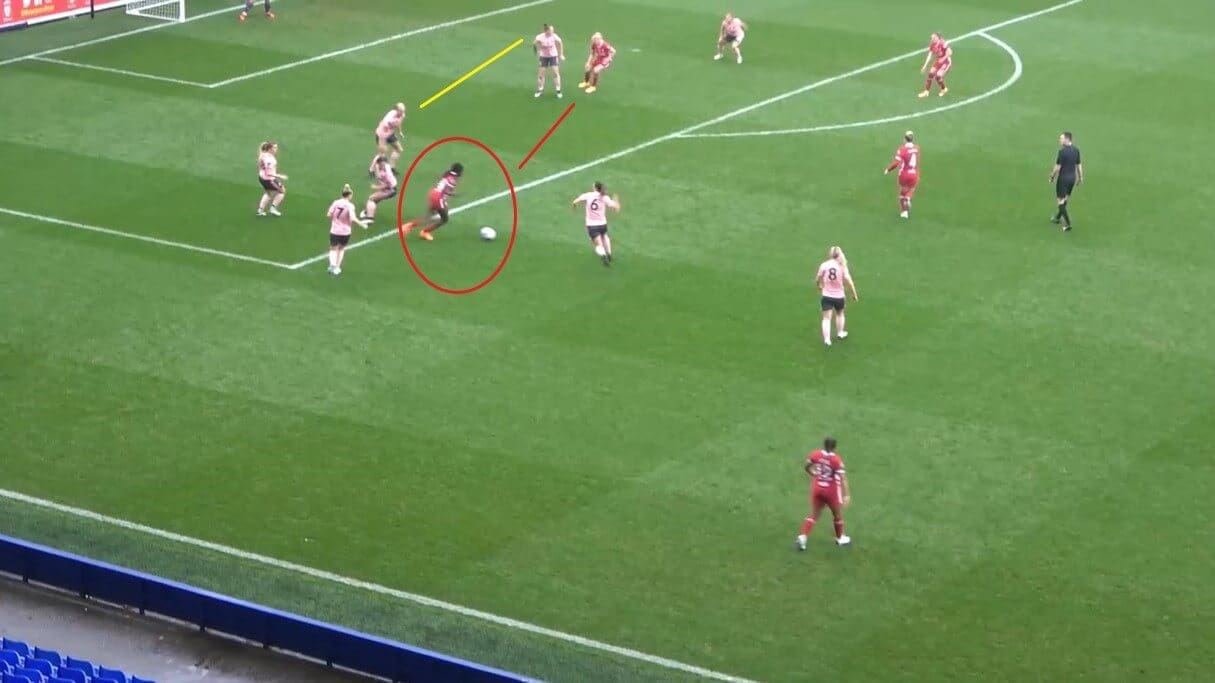
However, the thing that we have most noticed is that, by having both players at the top of the pitch, there has been more space for them to play in. In this image, against a Sheffield United Women team managed by former EFL manager Neil Redfearn, Babajide has the ball on the left side of the pitch, and is looking to find some space to shoot at goal through. Last season, she would have had no passing options ahead of her, and the opposing defenders would have surrounded and forced her to play backwards or sideways. However, now, we can see how Thestrup has taken some of the Sheffield United defenders away from her teammate, and that has created a gap in the defence to shoot through, as indicated by the yellow line.
From this section, we can see that, whilst Liverpool’s productivity is not as good as it could be, they still have players who work together to create opportunities. Amalie Thestrup has helped to link up play and increase Liverpool’s goal tally following her arrival, but she and Babajide need help from their teammates, and this is where the new manager needs to improve their attack.
Defensive positioning
As far as the defence goes, this is where Liverpool Women are perhaps strongest this season, having conceded the least number of goals in the Championship (eight in 11 games). However, the fact that they are eight points off the top of the table suggests that there are still areas here where they can improve and get even better. We will first look in this analysis at their defensive positioning.

The first thing to mention is that Liverpool defend with a high back line, pushing a long way up the pitch. However, as we can see here, they sometimes don’t co-ordinate with each other, meaning that gaps are left open in between them, and this is where opposing attackers find space to play in. Here, against Lewes, we can see how three defenders are in a line, but the fourth is behind, and that has given Lewes not only the space to play in, but also a way of transferring the ball into the space behind Liverpool’s defence. In order to fix this, Liverpool just need to communicate with each other much more, ensuring that all players are working together, meaning no gaps are left open.
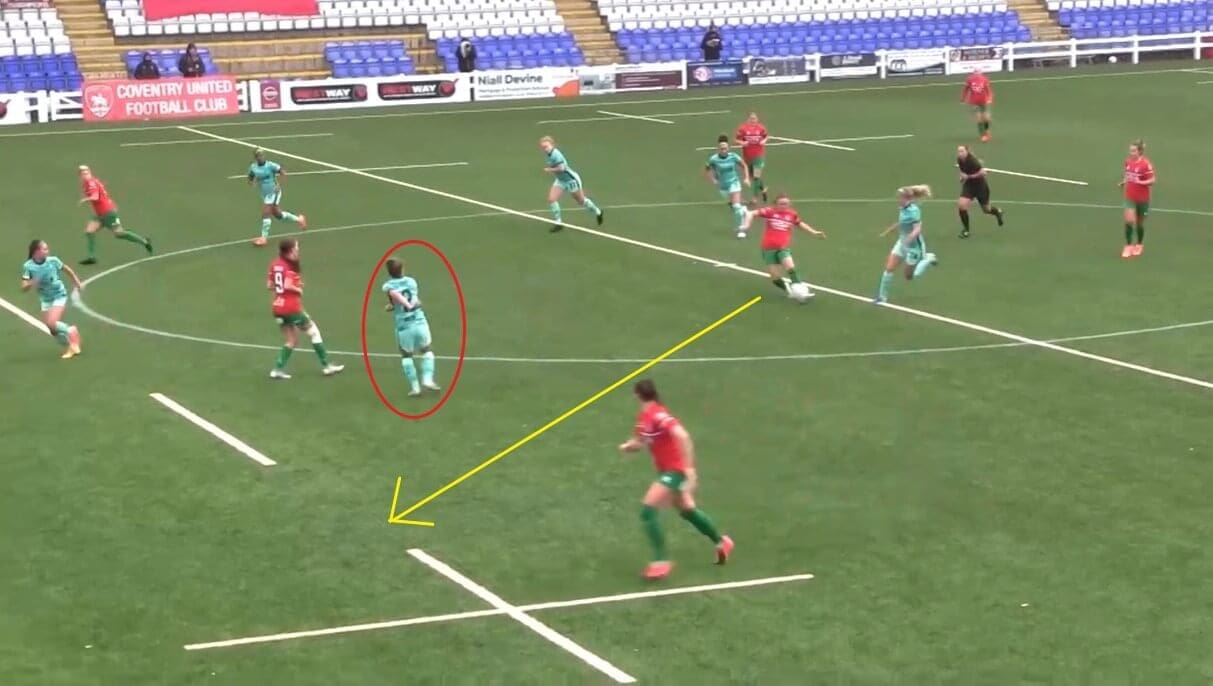
We can see another example here of Liverpool leaving space open at the back. We mentioned previously how Liverpool get their full-backs as high up the pitch as possible, supporting the attackers. However, the downside of that is that they often don’t slot in at the back as well as the centre-backs do, and that is the case here. Right-back Becky Jane has moved into the central channel, as the red circle shows, which has allowed Coventry United Ladies to move the ball behind Liverpool, around the side, as the yellow arrow shows. Therefore, again, Liverpool just need to communicate more on the pitch, ensuring that they don’t leave these spaces open, and this will make them harder to score against and to beat.
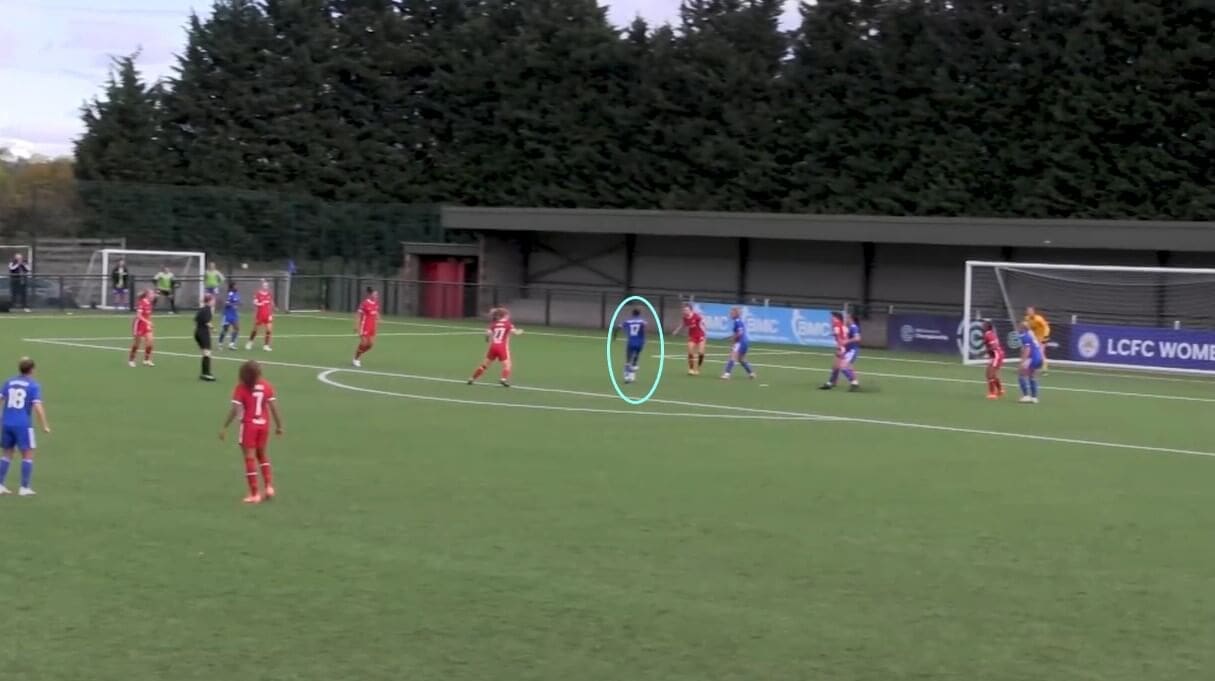
Here, against Leicester City Women, we can see another area where Liverpool can improve their defensive positioning. Liverpool have looked to protect the goal from any shot coming in from the wing, as you can see from their player-to-player marking in the box. However, in setting up in this way, they have left too much space open between their defensive ranks. This is because the midfielders have not come back to occupy that area, and that has allowed Leicester striker Paige Bailey-Gayle, in the blue circle, to control the ball and score from that position. Therefore, by tightening up at the back, and ensuring that opposing attackers don’t find these spaces, Liverpool can be harder to play against.
Individual errors
Whilst Liverpool Women’s defensive positioning has led to goals being conceded, one of the main reasons why opposing teams create plenty of chances against them is the individual errors they make.

Here, Rhiannon Roberts is operating in her usual central midfield position, but she has been surrounded by Lewes players, as the yellow lines show. She needs to be really sharp with her ball control here, but a poor pass ends up gifting the ball to Lewes. From this chance, the attackers can then get forward and put pressure on Liverpool’s defence, finding spaces where players are not able to get back in time. Therefore, this small error leads to an opposing attack that could have been prevented with better ball control.
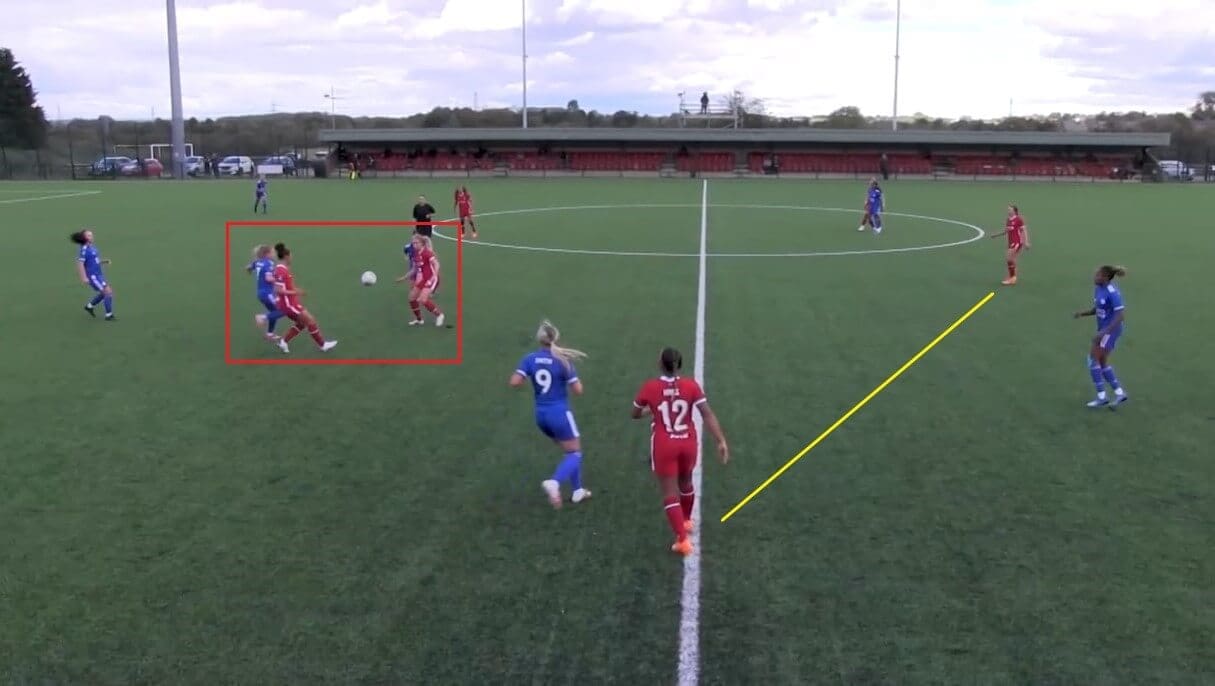
That has not been the only error in possession, as this image shows another example of Liverpool losing the ball in a key area. The red square shows two Liverpool players around the ball, but they both hesitate, not knowing which of them is going to control it. This small moment of indecision allows Leicester to come through the middle and win the ball easily.
Now, Liverpool are in a difficult position, because of their defensive structure. We can see how their high back line is again present, with left-back Taylor Hinds, who joined from Everton Women last summer, on the halfway line. The yellow line indicates the distance between her and her defensive teammate, and this is where Leicester play the ball through, unlocking the space behind. Therefore, again, an error in midfield has led to the opposing attacker winning the ball easily and causing problems for the defence, and this is another area where Liverpool can improve over the second half of the season.
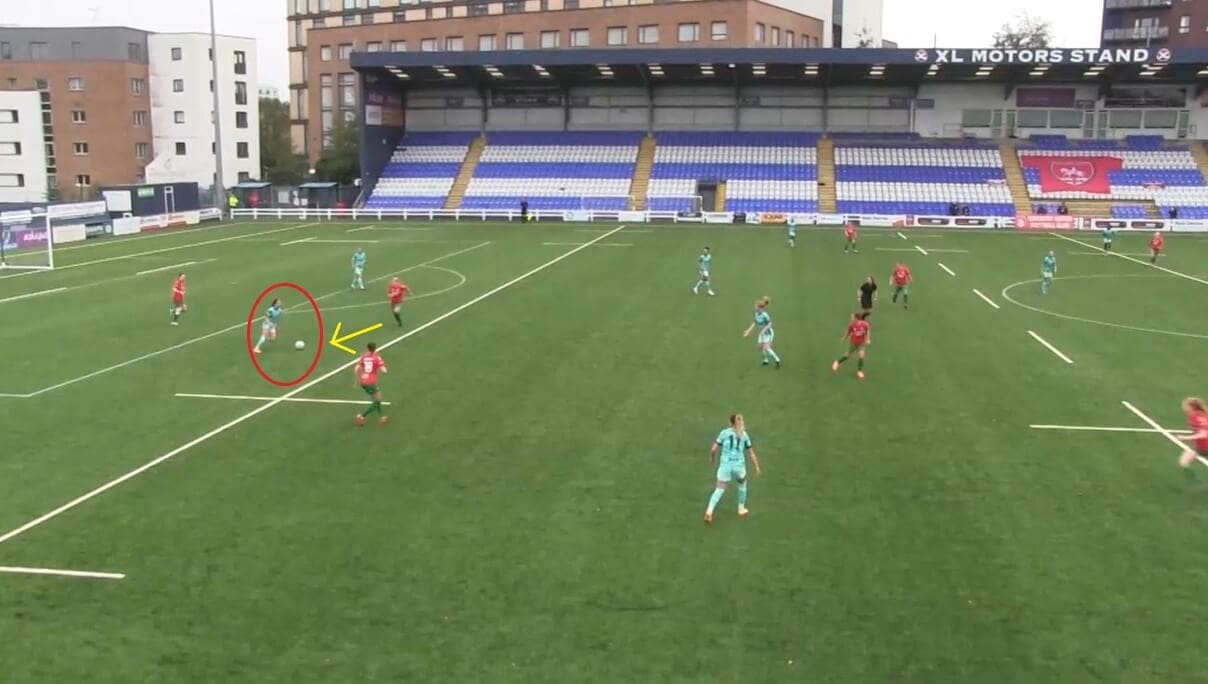
It’s not just in midfield that errors are made. Here, against Coventry, Liverpool are looking to play the ball out from the back. However, as they turn to find a pass, Coventry press them, as the yellow arrow shows, and win the ball. This means that the defence is put back under pressure to get back and block any attempted shot that Coventry make, which has come from a very avoidable situation. Therefore, one thing we can suggest for the new manager is that they work on eradicating these moments, with Liverpool needing to have better control of the ball at times, particularly against teams like Coventry and Crystal Palace who like to close it down quickly, lessening Liverpool’s passing options.
This section has given us a good idea of where Liverpool’s defence can be improved, making them harder to defeat. We have identified several areas where the new manager can change things, but we should also mention that their defence is much better this season than it was last season.
Conclusion
In conclusion, this analysis has looked at the reasons why Liverpool Women are perhaps misfiring at times this season, and some of the on-field reasons why manager Vicky Jepson has left the club this week. We have looked at their attack and defence, suggesting where they are going wrong and how to improve them. However, we also need to remember that they are a club with a low budget, preferring to bring players through from the academy rather than make big signings. This is where they struggle when compared to other women’s clubs. As the article title suggests, the opinion of many is that they are a club in disarray, but, on the pitch at least, there is a team that any manager can work with and improve, and, if they can work on the aspects we have focused on, then there’s no reason why they can’t return to the WSL at some point, if this season is too soon.





Comments